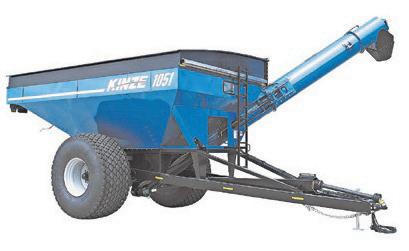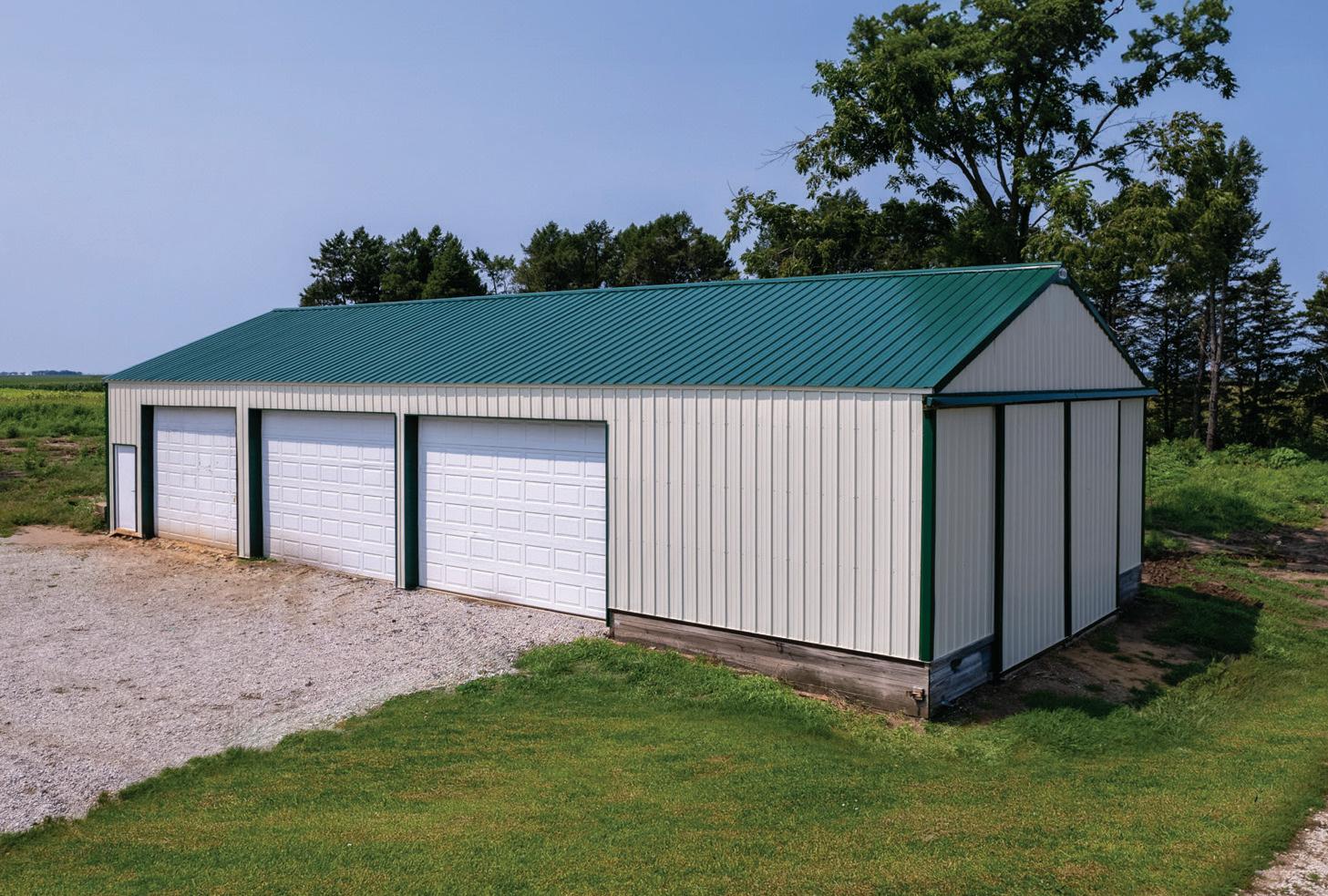MIDWEST AG EXPO 2025

January 22-23
Wednesday 8:30 a.m. to 4 p.m.
Thursday 8:30 a.m. to 3 p.m.
2205 County Rd. 3000 N Gifford, Illinois


January 22-23
Wednesday 8:30 a.m. to 4 p.m.
Thursday 8:30 a.m. to 3 p.m.
2205 County Rd. 3000 N Gifford, Illinois



• Storage step box fits S/STS series John Deere
• No modifications required
• Fully assembled box.
• Hardware and mounting brackets included
Fits the following
• Case IH
• Capello
• Drago
• Geringhoff
• Gleaner
• Harvestec
• John Deere
• Lexion
• Massey
• New Holland


Bonfield, IL (815) 426-2330
www.ndymfg.com
GPS Globe Lock

Globe Locks fit John Deere 3000, 6000, and 7000 series StarFire

Fits the following
• Massey
Option to add 36” x 20” x 12” storage box to fit your needs

• New Holland
• John Deere
• Case IH
• Challenger
• Works in 3 positions
• Easy fold and unfold
• Stores out of way for transport
• No modifications required
• Fits John Deere 1790/95 and 1770/75

• Versatile Mud Scrapers, Tow Hitches, and More.
Welcome to the 30th annual Midwest Ag Expo. It is with great pride and enthusiasm that we open the doors to this landmark event, celebrating three decades of agricultural innovation, collaboration and community.
Over the years, the Midwest Ag Expo has grown to become a cornerstone of the agricultural industry.
This year’s expo promises to be our most exciting yet, with a diverse lineup of exhibitors showcasing the latest advancements in farming technology, equipment and sustainable practices.
From groundbreaking machinery to cutting-edge solutions, the Midwest Ag


Expo is the premier destination for discovering the future of agriculture. Our event is more than just an exhibition — it is a celebration of the hard work and dedication of the farmers, producers and innovators who sustain our agricultural landscape.
To our exhibitors, thank you for your tireless efforts in preparing your displays and presentations. To our attendees, we are delighted to have you with us and hope that you

find the show both enlightening and enjoyable.
As we assemble together over the next few days, let us celebrate the past, present and future of agriculture. Together, we can cultivate a brighter, more sustainable future for generations to come.
Thank you for being a part of the 30th annual Midwest Ag Expo. We look forward to sharing this remarkable experience with you.
Jami Applegate, industry and association events manager NORTH AMERICAN EQUIPMENT DEALERS ASSOCIATION
















































623
BECK’S HYBRIDS 652
BLAIR’S DISC SHARPENING 718
CASE IH / BIRKEY’S FARM STORE 415
CASE IH PARTS & SERVICE / BIRKEY’S FARM STORE 515
CENTRAL ILLINOIS SCALE CO. 708
CENTRAL PETROLEUM COMPANY 610
CHAMPAIGN COUNTY SOIL & WATER CONSERVATION DISTRICT 721
BRUMLEVE INDUSTRIES 155
BURRUS SEED COMPANY 269
CAB FRESH FILTER COMPANY 253 CARLE HEALTH 317 CASCADE AG 383
CLAUSS SPECIALTIES 518
COACH HOUSE GARAGES 701
COMPASS INSURANCE 607
CONKLIN AGROVANTAGE 153
COUNTRY FINANCIAL — TANNA SUITS 665
COWELL AG INC. 561

CRAMER SIDING & WINDOW 709
CUTCO CUTLERY 706
CY CONSTRUCTION INC. 758
DAY DRAINAGE COMPANY 257
DEPKE WELDING SUPPLIES 101
DK TANKS & PIPE 569
DONMARIO SEEDS 376
DOUBLE Y SALES & SERVICE 287
DRONE DEPLOY AEROTECH 368
DUST & SON AUTO SUPPLIES 105
EASTERN ILLINI ELECTRIC COOPERATIVE 213
EDGE INSURANCE 410







MECHANICS LLC 326
FREDERICK COMMUNITY BANK 252
FRIENDS OF GREEN 103 FS CONSTRUCTION SERVICES / GROWMARK 452
GARAGE FORCE 265 GBL CONSTRUCTION 154 GIFFORD STATE BANK 603
GLASCOCK EQUIPMENT & SALES 556 & 658
GORDON FARMS SEED CO. 214

GORDON MILLWRIGHT SERVICE LLC 409
H & H GRAIN SYSTEMS LLC 263
HARVEST SOLAR 382
HELENA AGRI-ENTERPRISES 311
HOOVER’S FARM SUPPLY 112
HOTSY EQUIPMENT CO. 513
HUBNER INDUSTRIES LLC 700
I BEAM SLIDING DOORS 405
ILLINOIS STATE TREASURER 505
ILLIANA INSULATION INC. 714
ILLIANA TRUCK PARTS INC. 662
ILLINI FS 301

ILLINOIS GRAIN & SEED 615
INSURANCE PROVIDERS GROUP 715
ITOUCH LAB 507 IV CHEM 267
JENNER PRECISION 272
KEN’S OIL SERVICE 219
KENTLAND SEED 501
KUBOTA TRACTOR / BIRKEY’S FARM STORE 516
KUHNS EQUIPMENT 412 LANDOLL COMPANY LLC 451
LANZ HEATING & COOLING INC. 250













M & M PUMP CO. 208
MAATUKA AL-HEETI EMKES LLC 613
MANSEA METALS 264
MARTIN TILL 384
METLIFE INVESTMENT MANAGEMENT — AGRICULTURAL FINANCE 621
MH EQUIPMENT 753
MIDWEST AGRI SALES 212
MIDWEST AGRI SCIENCE LLC 511
MIDWEST APPLICATION 222
MIDWEST BIO-TECH INC. 514
MIDWEST GRASS & FORAGE 115
MIDWEST HOOP STRUCTURES 563
MISSISSIPPI STATE UNIVERSITY GEOSYSTEMS RESEARCH INSTITUTE 554
MOBIL WELDER 670
MORTON BUILDINGS INC. 381
MUENCH INC. 416 NAPA AUTO PARTS — PAXTON 608 NEWFIELDS AG 757 NU AG TECHNOLOGY GROUP 418
OTTAWA PLANT FOOD 121
PARKLAND COLLEGE 457
PAYLESS INSULATION 602
PHILO EXCHANGE BANK 716
PIONEER / CORTEVA 719
PORTABLE TENS LLC 666
POWERLIFT DOORS OF ILLINOIS 601




























By TOM C. DORAN tdoran@shawmedia.com
URBANA, Ill. — Bolstered by surprises in the December supply and demand estimates report, corn enters 2025 with strengths in exports and ethanol demand.
The U.S. Department of Agriculture surprised the market with hikes in corn exports by 150 million bushels and corn for ethanol use by 50 million bushels in last month’s balance sheet.
“The one thing we’ve seen is maybe more confirmation that old crop corn demand may be a little bit more real,” said Joe Janzen, University of Illinois agricultural economist.
“There was this notion that corn demand was a little more front-loaded this year with people trying to avoid the potential retaliatory tariffs and moving those sales up,” Janzen said.













“That still may be true to some degree, but there’s some confirmation that we’re in a pretty good export picture for corn and soybeans, but especially for corn.
“Just thinking about the overall supply and demand picture, we thought we
were going to keep building stocks and that’s going to be the overhang that prevents any sort of rally that might occur in the new year either on old crop or new crop pricing. We got a little bit of a reprieve from that.
“We’re still in a pretty well-supplied market situation, but definitely now th ere is the potential. I mean the market is already giving us some of that with
corn price closer to $4.50 per bushel than $4.”
Janzen compared corn demand to a three-legged stool, led by feed, ethanol and exports.
Ethanol use represents 36% of corn use, feed is 39% and exports 16%. The remaining 9% is for feed and other industrial use.
“Exports are really kind of the flex piece that picks

up the slack when we have a big crop like we had last year,” Janzen said.
“We’ve seen two solid months of really strong exports sales, particularly between the U.S. and Mexico. In the last few months, the export sales pace of actual shipments has moved above what is sort of normal for this time of year.
“Up to just before Thanksgiving, we’ve already shipped off about 1.25 billion bushels. That’s more than halfway to our total export sales for this marketing year. That’s above the historic pace, above the pace that we saw last year.
“Even if we don’t maintain this strong pace, we should get to USDA’s pro -
jection and fill that demand side of the balance sheet the way the market expects at this point.”
There has been a lot of chatter about the extent to which these sales — particularly to Mexico — are front-loaded to potentially avoid U.S. tariffs.











FROM PAGE 9
“If Mexico was to impose retaliatory tariffs on corn, they’d like to have a bulk of their exports for this year done before that happens,” Janzen said.
“I think the trade has a very mixed mind about that. I do think we can get to that 2.3 billion bushels this year. We’ve had such a good start already to the export program for corn to Mexico, but also to Latin
America.
“Colombia is a major destination for U.S. corn. That’s really been a bright spot where we were shipping a lot of corn to China two or three years ago and that really has shut down.”

Janzen
For 2024-2025, the USDA is anticipating continued supply growth, but not to the extent seen year-overyear between 2022 and 2023 in terms of total available

supply of corn. “We saw it grow more slowly, but we also anticipated usage would grow the same way that it did. Last year we saw the pace of use decline as we moved through the year. We saw a lot of corn move, particularly through the summer, that got us to a lower stocks-touse number than we were anticipating,” Janzen said.
“I’m really looking at pace of use as a key indicator. I’m also thinking about yield and acreage for next year. We saw a lot of reports of good yields this last growing season in different parts of the country.
“U.S. farmers have been able to grow yields using modern technology and production practices, high-quality farm management techniques. We saw a pretty big crop, but only slightly above trend line.
“It’s not outside of the historical experience to see 10 bushels per acre above trend. If we get 10 bushels above trend, prices will have to move lower, especially at harvest.”
The corn-soybean price ratio favors corn in 2025.
“I think USDA has it right that it will favor corn in 2025 and we will see a swing back to corn acres,” Janzen said.

tainty about that international demand peak,” Janzen said.
market going forward.


“For historical context, the trend yield for U.S. corn and soybeans yields have followed a remarkably stable trend with 35 years of basically linear growth. We deviate from trend line a little each year, but it’s remarkably consistent.
“Since 1990, that ratio has been about 2.3 and over the last decade that’s favored corn strongly over soybeans.”
What does all of this mean for corn going into 2025?
“We will get more cer -
“USDA’s long-run production projection is a pretty conservative estimate for production at 182 bushels per acre (for its 2025-2026 baseline) with a little bit of a pullback in export demand to 2.275 billion bushels.
“Putting that all together, we’re still adding 300 million bushels to ending stocks. We’re continuing to grow the stocks-to-use ratio. That’s going to weigh on the
“There is a little bit of good news as we think about what that means for prices. I think we are down in a level where we’re going to see some responses by some of our trading partners to low prices and see some of that crops soaked up in terms of ending stocks and prices don’t fall that much further.
“But they do have to fall a little bit if we see higher corn acres. Prices kind of line up with that expectation.”














By TOM C. DORAN tdoran@shawmedia.com
URBANA, Ill. — Global soybean supplies that are already at high levels are expected to grow in the first months of 2025.
“You have to be sort of less bullish given the very, very narrow trading range that we’ve been in for the last few months,” said Joe Janzen, University of Illinois agricultural economist.
Brazil farmers begin their soybean harvest in January with production estimated at 169 million metric tons, or nearly 6.210 billion bushels.
“With that big Brazilian crop coming, the world supply-demand situation is already at very high stocks
levels, and that is expected to grow through this next marketing year. Every Brazil crop estimate that we’ve seen come out is inching higher. We’re going to get some confirmation on that in January,” Janzen said.
Brazil also continues to add large chunks of soybean acreage each year.
“The big thing weighing on the soybean market and why we see strength for corn relative to soybeans is we’ve seen almost 20 years of year-over-year growth in Brazilian soybean acres,” Janzen said.
“They’re adding three million, four million acres every year of soybeans, partly because they’ve been able to shift corn production to a second crop in the major production
region. They’ve also been able to convert a lot of degraded pasture lands to soybean production.
“That will continue to weigh on the market no matter what news we get about weather. They’re adding another three million acres this year. They added five million the year before. They added six million the year before that.
“Even if we don’t plant a single additional acre of soybeans in the U.S., this is going weigh on our prices here.
“The market is certainly saying, ‘We don’t expect the need for higher soybean prices to ration out soybeans anytime soon. The market is well supplied.’”

“Biofuels
Joe Janzen, agricultural economist






That is especially true when it comes to farming. For more than 130 years, Central Illinois Mutual Insurance Company has strived to make insuring Illinois farmers simple. We provide the coverage they need and the service they expect, at a price they can afford.
That is especially true when it comes to farming. For more than 130 years, Central Illinois Mutual Insurance Company has strived to make insuring Illinois farmers simple. We provide the coverage they need and the service they expect, at a price they can afford.
CIMply CIMICO … We’re your insurance company!
CIMply CIMICO … We’re your insurance company!
To simplify your farm




FROM PAGE 12
Meal production and exports are critical pieces of the soybean demand pie. Soybean meal production represents 45% of demand, exports is 43%, 6% is oil for biofuels and 6% is for oil for food and other uses.
“We’ve heard a lot of talk about a renewable diesel boom, about the importance of biofuels for the soybean market, but it’s important to remember that domestically crushed soybeans for biofuels is only about 6% of the total U.S. soybean volume” Janzen said.
“We’ve seen the smaller



portions of the pie get a little bit bigger mainly because of the growth in biofuels, but exports are still critical.
“As we think about how does this supply and demand situation change as we move forward through the remainder of the 20242025 marketing year and into marketing the 2025 crop, we should keep those use proportions in the back of our minds.”
There has been some strengthening in domestic crush demand.
See SOYBEAN, Page 15








Winter Meeting 1 Feb. 3rd - 10:00am
Lunch Provided! ILlinois Soybean Assoc. 1108 Trinity Lane bloomington, IL

Winter Meeting 2 Feb. 5th - 10:00am


Lunch Provided! effingham event center 1501 W Fayette Avenue effingham, IL
#150 Gordyville, USA Can’t make it to a meeting? Visit us at the Midwest Ag Expo in late January! Our Booth: #150
Yield Profit Challenge specializes in improving yield and input efficiency. We offer a unique, organic -or- conventional input system that consistently delivers high-net-profit corn and soybean plots at Precision Planting’s PTI Farm in Pontiac, IL.
(309) 339-2954

+50% | P: +47% | K: +40%
owned and operated since 2017.



Yield Profit growers enjoy better plant health, tougher roots, and increased resistance to disease and drought. The program increases efficiency by unlocking existing nutrients in the soil. Enjoy increases of:


“We’ve seen new crush capacity come on line over the last several years. There’s some room for that to continue going into 2025,” Janzen said.
“We have seen exports bounce back from a comparatively poor 2023. There’s been a little bit of strength in demand for U.S. soybeans around the world, but the overall story is one of stock growth.”
There has been a shift in soybean export seasonality trends the last few years.
“The last few months have been pretty positive, but the worry is we see the export sales program turn to what happened last year where over time we’ve seen a change in the seasonality of the soybean market,” Janzen said.
“We’ve typically seen de -
mand for U.S. soybeans is strong up until January or February and then the tap starts to shut off. However, the last couple of years we get to January and the Brazilian soybeans come to the international market and the demand for U.S. soybeans really kind of dried up.
“Soybeans to China is really a two-horse race between the U.S. and Brazil. September through the end of the year, there’s a big movement of U.S. soybeans and then the tap shuts off and all of the movement is dominated by Brazil. The U.S. component of that export picture has shrunk a little bit.”
The soybean stocks-to-use ratio was 6.1% in 2022-2023 when the season average price was $14.20 per bushel. It increased to 8.3% in 20232024 with an average price of $12.40 per bushel.
USDA’s December sup -
ply and demand estimates have a 10.8% stocks-to-use and projected average price of $10.80.
“The amount of inventory we have at the end of the marketing year is growing relative to the amount that we’re using. This market is reasonably well-supplied at anything over a 10% stocks-to-use ratio. We moved there last year,” Janzen said.
“We’re going to grow stocks if we have a normal crop in the U.S. Even with a little growth in domestic crush and exports, we keep growing stocks.
“USDA’s average prices is at $10.80 for this year. It’s hard to sell soybeans at $10.80 in the market. There’s not too many sales, particularly in the last six months.
“The big thing is we keep building stocks and it keeps weighing on the market.”
Crop prices have fallen to long-range average lev-
els with the tariff shadow overhead.
“There are a whole set of threats, especially geopolitical, that could mean lower prices in the short run. You want to look for opportunities, have a marketing plan that commits you to action if we do get rallies,” Janzen said.
“The wins are going to be relatively small. So, it’s not going to be $1 a bushel or $2 a bushel. We’re thinking more like 25- to 50-cent rallies are opportunities to make grain sales.
“More sophisticated marketing tools do not automatically produce wins. That’s what our date from the Illinois Farm Business Farm Management shows.
“If we’re thinking about post-harvest grain marketing in particular, weigh the full cost of making that decision. All gains and losses must be calculated net for the full cost when storing grain.”










